Making Crêpes

What’s the difference between crêpes, blintzes, blini and just plain ol’ skinny pancakes? Don’t answer that. I don’t want to know. Probably much less than the French, Slavs, Russians or English would ever want to admit.
Ultimately the only difference between all of them is context. Blintzes go with applesauce, blini with caviar, pancakes with sugar and lemon (or syrup) and crêpes…well, with just about anything. For indeed in France a crêpe is a medium…for sweet things, savory things and anything in between. Sort of like sandwich bread, it becomes what it contains.
Another distinct thing about crêpes: they’re the only pancakes I know that are served in different shapes depending on what’s in them. Above you see what crêpes often look like when they’re served as a sweet: folded into quarters. In savory applications they’re typically rolled into tubes.
But I’m getting ahead of myself. We need to make them first. So then, with all the ingredients from recipe post below arrayed before you, place them into a blender in order: milk, water, eggs, flour, etc…
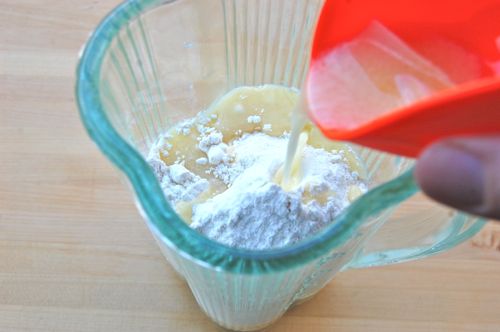
Pulse the blender until a batter forms (about 30 -45 seconds of blending in total). Scrape down the sides of the blender with a spatula to make sure there aren’t any lumps…

…then blend another 15 seconds or so until the batter is smooth. Put the lid on the jar/pitcher (whatever you call that thing) and put it into the refrigerator for at least an hour and up to 48 hours if you wish. This allows the bubbles to rise out of the batter, which is a good thing, because bubbles will make the pancakes rigid (no good).
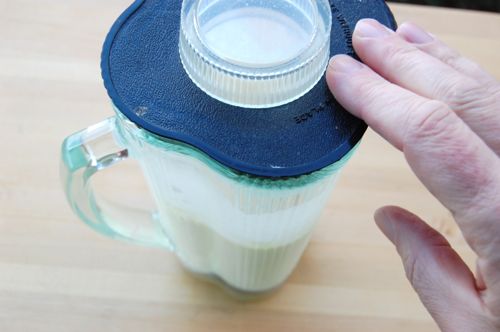
When you’re ready to make the crêpes, have a look to see if the batter has separated. If so, give it a gentle stir with a spoon.
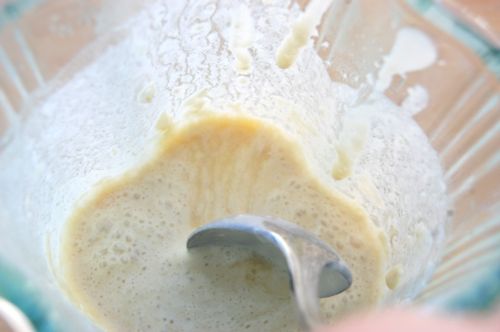
Meanwhile heat a 9″ nonstick skillet or crêpe pan over medium-high heat. When it’s hot, quickly brush on a little melted butter.
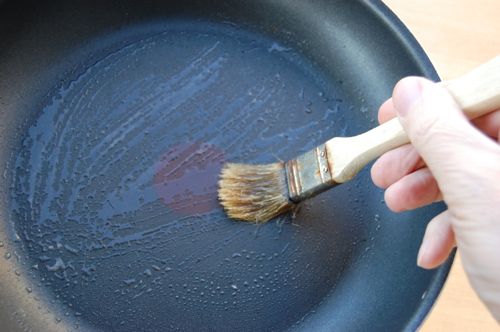
Pour in about a 1//4 cup of the batter.

Quickly tilt the pan one way…

…then the other, to get fairly even coverage. Try to keep the layer thin all the way around.
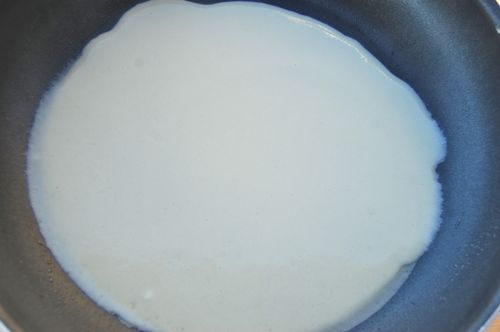
Cook the crêpe for about 30 seconds. You’ll see steam pockets here and there, and the very edges will start to rise off the surface of the pan.

At that point you should be able to slide your turner underneath. If not, try lifting up the edge with your fingers first (that’s not technically cheating).
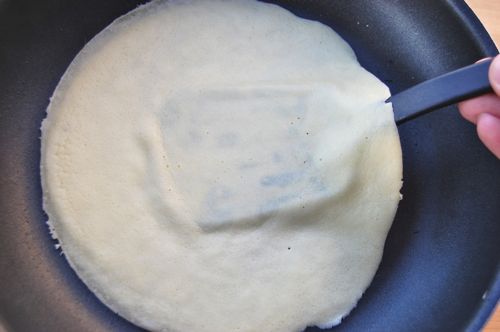
And in one smooth motion flip the crêpe over. It isn’t difficult, just don’t show fear, which crêpes can smell. You don’t want them too dark — just a few brown spots. That way they stay supple and roll-able.
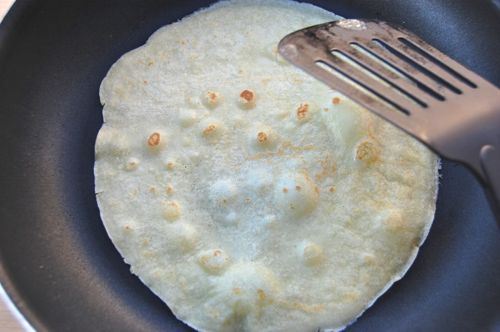
Cook another 20 seconds or so until the second side is lightly browned. Then simply slide the crêpe onto one of the four waiting “cooling plates” you have set up on the counter near the stove.
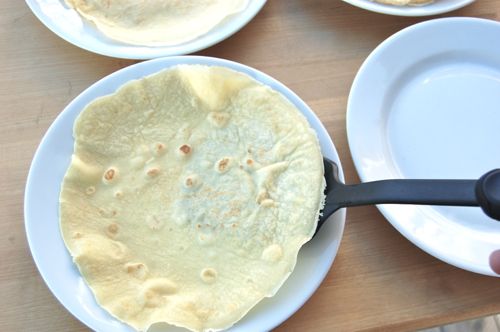
When you’ve made four, slide the three coolest crêpes onto a fifth plate, which contains your stack:
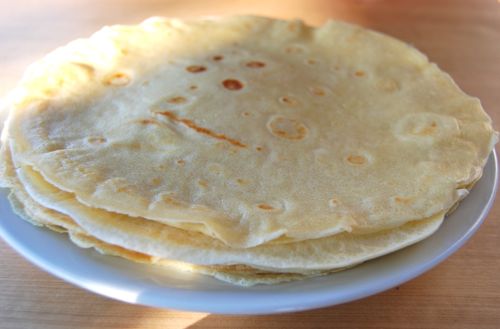
When you’ve made all ten, let the stack cool while you tidy up the dishes (or ask your spouse and/or children to do it for you), then wrap the stack in plastic wrap until you’re ready to serve them. They’ll keep for several days in the refrigerator or several weeks, even months, in the freezer. Just be sure, if you store them, to warm the chilled and/or thawed crêpes before you attempt to fold or roll them. Otherwise they’ll probably crack. Crêpes can be re-warmed either in a pan or with a 5-7 second zap of high microwave heat.
Oh and I promised to show you what savory crêpes typically look like when they’re plated. About like this, though savory crêpes tend to be made with a buckwheat batter:
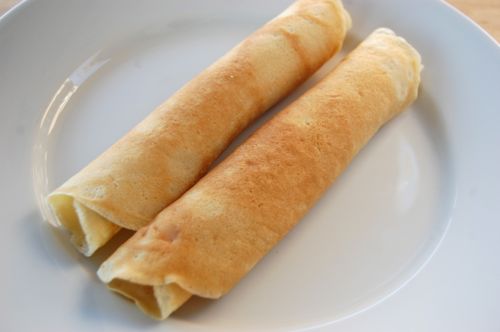
No I’m not going to tell you what’s inside. This photo was taken solely for the purposes of demonstration. But suffice to say there isn’t much of whatever-it-is inside. About three tablespoons.
And that’s all you want to put inside a crêpe, trust me. Sure, some people will stuff a crêpe like a Denver omelet, but when you do that you mostly lose the simple, eggy flavor and gentle chew that crêpes add to your dinner or dessert.
Think of the crêpes themselves as the main attraction and the filling/topping as the condiment. That’s the best way to experience a good crêpe. Now go forth and do like the French do — eat!
I have high hopes for the crepes we’re planning to make closer to Christmas time…. 🙂 chocolate and poached pears, mmm! Thanks for providing the inspiration Joe!
Wow…does that ever sound great. Send pictures!
It appears that some people here haven’t quite grasped the difference between blini (savoury) and the NZ pikelet (sweet), have been to many Christmas functions where pikelets have been served with toppings which would have worked better on blini. Most recently smoked salmon and cream cheese on pikelets, yerk.
But you can not go past a good old pikelet with lemon curd or jam and cream.
Joe, I thought blintzes were crepes but only cooked on one side. Then you fill the cooked side and after folded, saute the uncooked (now outside) in butter. Is this so?
Hey Linda! I have a blintz tutorial up as well. You’re right that the cooking process is different. You don’t want to brown blintzes much if at all. Indeed that’s for the pan-frying step. But in terms of what they’re made from, their thickness and diameter…they’re practically identical.
– Joe
That’s certainly what I grew up with!
Reader Jill adds:
I follow your blog regularly and find it a mine of very interesting information. However, I have to “intervene” regarding the shapes crêpes are served in over here in France! It’s simply not as black-and-white as you describe in your post, and in fact seems to have more to do with the consistency of what is inside the crêpe as well as with the esthetic “statement” the chef wants to make. Sure, dessert crêpes can be folded in four, but served with a scoop of ice cream or a mound of chantilly to complement the contents (butter-sautéed apples or pears, jam, or whatever), they are frequently folded up on the four edges, turning the crêpe into a square with the ice cream or chantilly in the center hollow. This same shape is frequently used for the “complète”, a main-course crêpe (or more frequently a buckwheat “galette”) filled with a thin slice of ham, a fried egg and grated gruyère, as well as being used “just because” the chef wants to. Also common is a crêpe folded in thirds to make a long rectangle with curved ends. And there are other shapes as well, all depending on the inventiveness of the chef! What just isn’t the case is that a particular shape is reserved for only sweet crêpes or only savory ones.
Excellent stuff, Jill In my defense I’ll say I didn’t mean to imply that crêpes are never fashioned in other shapes, more that they’re presented in different ways depending on what’s inside them (which is sort of what you’re saying). Also I’ll say that the sweet/savory distinction I referenced was probably a lot truer twenty or thirty years ago. I’m certain that nowadays just about anything goes.
“No I’m not going to tell you what’s inside.”
If you are going to be “that way”, then I will guess: it’s a hot dog inside… isn’t it?
No, smarty pants. Mozzarella cheese sticks, still in the wrapper. You’ve heard of the horrors of food photography. This is one of them. Just goes to show there isn’t much room in a good crepe for extra food!
– Joe
Oh my! The only way I can imagine eating crepes is for dessert–with a little Grand Marnier, sugar, orange zest, and butter. I first ate them that way while living in Europe. Thank goodness the little French country restaurant nearby serves them, too.
I remember back when I was in 6th grade, in a class where we learned about different cultures of the world, we had a unit on France and we made crepes in class (topped with vanilla ice cream). I remember distinctly that the teacher taught us that crepes are only cooked on one side. Have you ever heard that?
Hey, Eva!
Some members of the Very Skinny Pancake family are only griddled on one side. Blintzes spring to mind. Most of the time crepes are cooked on both sides, but it wouldn’t surprise me of some people only did one side.
– Joe
The second side of my crepes only get a “courtesy visit” on the pan. I flip them over, then flip them off… fast.
They are the best with Nutella … I am originally from Europe, so I know it. Great blog, glad to find it.
I agree, Ivana, there’s no beating the classics.
– J